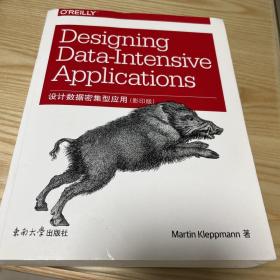
设计数据密集型应用(影印版)
¥ 46 4.6折 ¥ 99 九五品
仅1件
北京东城
认证卖家担保交易快速发货售后保障
作者Martin Kleppmann 著
出版社东南大学出版社
出版时间2017-10
版次1
装帧平装
上书时间2023-03-19
- 在售商品 暂无
- 平均发货时间 暂无
- 好评率 暂无
- 最新上架
商品详情
- 品相描述:九五品
图书标准信息
- 作者 Martin Kleppmann 著
- 出版社 东南大学出版社
- 出版时间 2017-10
- 版次 1
- ISBN 9787564173852
- 定价 99.00元
- 装帧 平装
- 开本 16开
- 纸张 胶版纸
- 页数 590页
- 字数 754千字
- 【内容简介】
-
书中包含以下内容:
? 深入分析你已经在使用的系统,并学习如何更高效地使用和运维这些系统
? 通过识别不同工具的优缺点,作出更明智的决策
? 了解一致性、可伸缩性、容错性和复杂度之间的权衡
? 理解分布式系统研究,这些研究是现代数据库构建的基石
? 走到一些主流在线服务的幕后,学习它们的架构
- 【作者简介】
- Martin Kleppmann,是英国剑桥大学的一名分布式系统研究员。在此之前他曾是软件工程师和企业家,在 Linkedin 和 Rapportive 工作过,从事大规模数据基础设施相关的工作。Martin 经常在大会做演讲,写博客,也是开源贡献者。
- 【目录】
-
Part I. Foundations of Data Systems
1. Reliable, Scalable, and Maintainable Applications 3
Thinking About Data Systems 4
Reliability 6
Hardware Faults 7
Software Errors 8
Human Errors 9
How Important Is Reliability? 10
Scalability 10
Describing Load 11
Describing Performance 13
Approaches for Coping with Load 17
Maintainability 18
Operability: Making Life Easy for Operations 19
Simplicity: Managing Complexity 20
Evolvability: Making Change Easy 21
Summary 22
2. Data Models and Query Languages 27
Relational Model Versus Document Model 28
The Birth of NoSQL 29
The Object-Relational Mismatch 29
Many-to-One and Many-to-Many Relationships 33
Are Document Databases Repeating History? 36
Relational Versus Document Databases Today 38
Query Languages for Data 42
Declarative Queries on the Web 44
MapReduce Querying 46
Graph-Like Data Models 49
Property Graphs 50
The Cypher Query Language 52
Graph Queries in SQL 53
Triple-Stores and SPARQL 55
The Foundation: Datalog 60
Summary 63
3. Storage and Retrieval 69
Data Structures That Power Your Database 70
Hash Indexes 72
SSTables and LSM-Trees 76
B-Trees 79
Comparing B-Trees and LSM-Trees 83
Other Indexing Structures 85
Transaction Processing or Analytics? 90
Data Warehousing 91
Stars and Snowflakes: Schemas for Analytics 93
Column-Oriented Storage 95
Column Compression 97
Sort Order in Column Storage 99
Writing to Column-Oriented Storage 101
Aggregation: Data Cubes and Materialized Views 101
Summary 103
4. Encoding and Evolution 111
Formats for Encoding Data 112
Language-Specific Formats 113
JSON, XML, and Binary Variants 114
Thrift and Protocol Buffers 117
Avro 122
The Merits of Schemas 127
Modes of Dataflow 128
Dataflow Through Databases 129
Dataflow Through Services: REST and RPC 131
Message-Passing Dataflow 136
Summary 139
Part II. Distributed Data
5. Replication 151
Leaders and Followers 152
Synchronous Versus Asynchronous Replication 153
Setting Up New Followers 155
Handling Node Outages 156
Implementation of Replication Logs 158
Problems with Replication Lag 161
Reading Your Own Writes 162
Monotonic Reads 164
Consistent Prefix Reads 165
Solutions for Replication Lag 167
Multi-Leader Replication 168
Use Cases for Multi-Leader Replication 168
Handling Write Conflicts 171
Multi-Leader Replication Topologies 175
Leaderless Replication 177
Writing to the Database When a Node Is Down 177
Limitations of Quorum Consistency 181
Sloppy Quorums and Hinted Handoff 183
Detecting Concurrent Writes 184
Summary 192
6. Partitioning 199
Partitioning and Replication 200
Partitioning of Key-Value Data 201
Partitioning by Key Range 202
Partitioning by Hash of Key 203
Skewed Workloads and Relieving Hot Spots 205
Partitioning and Secondary Indexes 206
Partitioning Secondary Indexes by Document 206
Partitioning Secondary Indexes by Term 208
Rebalancing Partitions 209
Strategies for Rebalancing 210
Operations: Automatic or Manual Rebalancing 213
Request Routing 214
Parallel Query Execution 216
Summary 216
7. Transactions 221
The Slippery Concept of a Transaction 222
The Meaning of ACID 223
Single-Object and Multi-Object Operations 228
Weak Isolation Levels 233
Read Committed 234
Snapshot Isolation and Repeatable Read 237
Preventing Lost Updates 242
Write Skew and Phantoms 246
Serializability 251
Actual Serial Execution 252
Two-Phase Locking (2PL) 257
Serializable Snapshot Isolation (SSI) 261
Summary 266
8. The Trouble with Distributed Systems 273
Faults and Partial Failures 274
Cloud Computing and Supercomputing 275
Unreliable Networks 277
Network Faults in Practice 279
Detecting Faults 280
Timeouts and Unbounded Delays 281
Synchronous Versus Asynchronous Networks 284
Unreliable Clocks 287
Monotonic Versus Time-of-Day Clocks 288
Clock Synchronization and Accuracy 289
Relying on Synchronized Clocks 291
Process Pauses 295
Knowledge, Truth, and Lies 300
The Truth Is Defined by the Majority 300
Byzantine Faults 304
System Model and Reality 306
Summary 310
9. Consistency and Consensus 321
Consistency Guarantees 322
Linearizability 324
What Makes a System Linearizable? 325
Relying on Linearizability 330
Implementing Linearizable Systems 332
The Cost of Linearizability 335
Ordering Guarantees 339
Ordering and Causality 339
Sequence Number Ordering 343
Total Order Broadcast 348
Distributed Transactions and Consensus 352
Atomic Commit and Two-Phase Commit (2PC) 354
Distributed Transactions in Practice 360
Fault-Tolerant Consensus 364
Membership and Coordination Services 370
Summary 373
Part III. Derived Data
10. Batch Processing 389
Batch Processing with Unix Tools 391
Simple Log Analysis 391
The Unix Philosophy 394
MapReduce and Distributed Filesystems 397
MapReduce Job Execution 399
Reduce-Side Joins and Grouping 403
Map-Side Joins 408
The Output of Batch Workflows 411
Comparing Hadoop to Distributed Databases 414
Beyond MapReduce 419
Materialization of Intermediate State 419
Graphs and Iterative Processing 424
High-Level APIs and Languages 426
Summary 429
11. Stream Processing 439
Transmitting Event Streams 440
Messaging Systems 441
Partitioned Logs 446
Databases and Streams 451
Keeping Systems in Sync 452
Change Data Capture 454
Event Sourcing 457
State, Streams, and Immutability 459
Processing Streams 464
Uses of Stream Processing 465
Reasoning About Time 468
Stream Joins 472
Fault Tolerance 476
Summary 479
12. The Future of Data Systems 489
Data Integration 490
Combining Specialized Tools by Deriving Data 490
Batch and Stream Processing 494
Unbundling Databases 499
Composing Data Storage Technologies 499
Designing Applications Around Dataflow 504
Observing Derived State 509
Aiming for Correctness 515
The End-to-End Argument for Databases 516
Enforcing Constraints 521
Timeliness and Integrity 524
Trust, but Verify 528
Doing the Right Thing 533
Predictive Analytics 533
Privacy and Tracking 536
Summary 543
Glossary 553
Index 559
点击展开
点击收起
— 没有更多了 —












以下为对购买帮助不大的评价